Spey casting is highly addictive.
After three years of fishing Skagit heads on single hand rods I finally took the plunge and purchased a double handed stick. A decision prompted by an approaching birthday and Sage’s release of its highly acclaimed Trout Spey HD series, built with the same technology as my favourite single handed Spey casting tool, the magical 5 wt 9.5 foot Sage X-597.
I have often read and heard it said that the terms ‘Trout Spey’ and ‘Switch Rod’ are synonymous. Although both are short double handers (<12 ft long), they are designed for different purposes.
Switch rods are intended for use with one and two hands, and for both overhead and Spey casting - e.g. they are often used for indicator nymphing - and consequently have a similar flex profile to a single hander.
Trout Spey rods, on the other hand, have a more progressive taper with more flex in the lower section, allowing the rod to load fully and to transfer more feel to the angler during the relatively slow stroke of a water loaded Spey cast. They are therefore easier to cast with both 'sustained anchor' and 'touch and go' casts, than are switch rods. Given my addiction to Spey casting, the choice was an easy one.
The Sage Trout Spey HD series includes a 10.75 foot 1 wt, a 10.75 foot 2 wt, a 10.25 foot 3wt, an 11 foot 3wt, and an 11.25 foot 4wt. Double handed rods have a different line rating to single hand rods and to compare them directly one has to add the number three to the single hand rating.
A 2 wt double hander would therefore cast a similar line weight to a 5 wt single hander. I chose the 4wt Trout Spey because, apart from the challenge of casting with two hands, I wanted a rod that would give me a bit more distance on larger rivers, and make casting 300 grain heads and heavy sink tips and streamers a little easier than with my 7wt single-hander.
Casting with two hands
I used my new rod for the first time on the Hydro Pool on the Tongariro River on 2 December 2019. The line I used, that day and for the remainder of the trip, was a 325 grain Scandi Body (that actually weighed 315 grains) and a 10 foot #6 S6 Rio Replacement Tip. The outfit was superbly balanced, but the caster was not. Transitioning from single hand to two handed Spey casting was more difficult than I had anticipated.
For starters, my success with heavy tips and streamers on single handed rods resulted from a rotation of the right wrist, and a haul with the left hand, both executed late in the forward delivery. As every accomplished two-hand-caster knows, rotation of the right wrist drops the rod tip too low, opens up the loop, and causes the line and tip to land in a heap.
I was also used to putting more effort into Spey casts with single hand rods, which resulted in more than a few blown anchors using the double hander.
Once I learned to tap back on the power and use bottom-hand-pull to achieve the paint-brush flick, the rod sprung to life in the same magical way as the X-597, firing miraculously tight loops right across the river.
The Rio Scandi Body came to my attention through the excellent reviews by the folk at Ashland Flyshop in the U.S. At 23 foot long it is shorter than a regular compact Scandi head, and the tip is also considerably thicker.
It nevertheless has a long 16 foot front taper, and when you choose one with a grain weight similar to that of the Skagit for a particular rod, you end up with a hybrid head that is much more graceful than a Skagit, but has more power than a Scandi to handle wind and heavier tips and flies.
The 325 grain Scandi Body excelled at touch and go and sustained anchor casts and was brilliant with 10 foot 6wt Replacement Tips and streamers with medium weight (rabbit streamers and buggers with 4 mm brass bead).
It is therefore a great line for summer and autumn on big rivers.The recently introduced Rio Trout Spey head has a similar profile, although a foot shorter, but is not available in half line sizes, such as 325 grains.
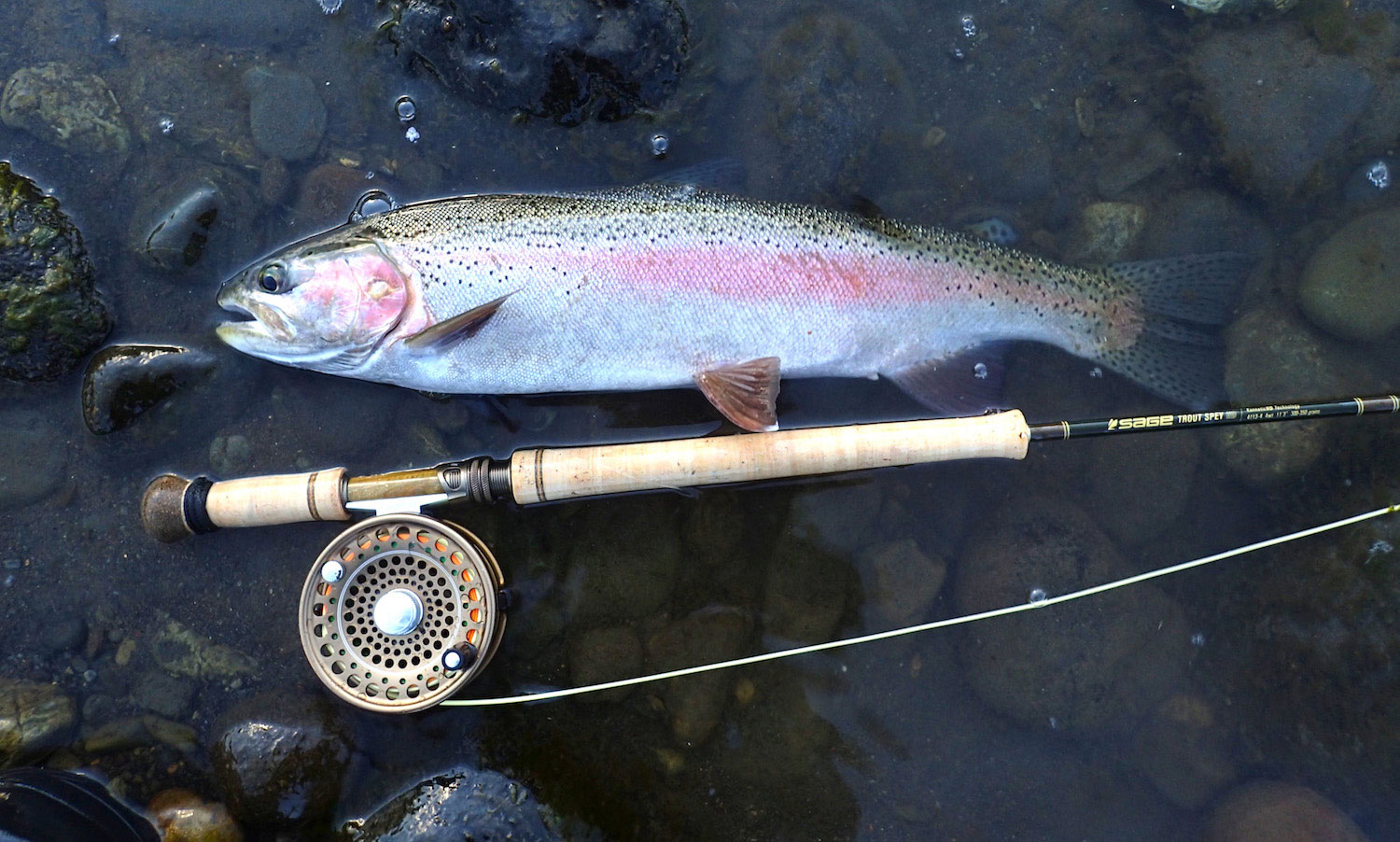
Finding a Skagit Head
When we returned from the Tongariro I began my search for a Skagit head that suited me and the rod.
New Zealand rivers may not be large by international standards, but they often have high gradients, strong flow and deep pools that require decent sink tips to reach fish.
A compact Skagit head, less than 18 ft for example, was the obvious choice as they cast longer and heavier tips than a longer head. Other advantages are that they allow some stripping and require less casting room.
Casting compact Skagit heads with a double hander came with its own learning curve. For example, the full horizontal to vertical sweep I used for single hand Skagit casting, and with the Scandi Body on the Tongariro, resulted in numerous blown anchors - Tom Larimer’s 45 degree martini glass sweep being a solution to that problem.
I also had to learn to start the sweep far slower than seemed feasible, to keep the stroke compact and remember to use the bottom hand to create acceleration at the end of the stroke.
When it all clicked, the magic happened all over again, and it took some time for me to stop chuckling after each cast.
After testing a wide range of heads from 240 to 325 grains, I settled on a 15.5 foot 300 grain Airflo Skagit Scout. A 270 grain Scout felt a little too light to adequately load the rod, and a 325 grain Rio Skagit Trout Spey felt a little on the slow and spongy side - I did not try the 300 grain version.
The Scout 300 had just the right balance of weight and line speed for my casting style. Eighty foot casts with heavy streamers and 10 feet of T-11, light 3D MOW tips, and 10 foot Airflo T-7 and T-10 FLO tips were effortless with this head.
While I could manage a T-14 FLO tip with the 300 grain Scout, it did feel a little clunky, compared to the other tips.
My choice for going deeper in pools and runs of uniform depth was a 14.5 ft 270 grain Scientific Anglers Intermediate Skagit Lite, with a S5/S6/S7 3D light MOW or a 10 foot OPST 210 grain bucket tip.
Although the OPST tip has the same weight as 10 ft of T-11, it has the sink rate of T-14, i.e. 8-9 tips. The intermediate head sliced through wind, landed with surprisingly little splash and remained at depth throughout the swing.
On a trip to the Tongariro in August 2020, I caught many fish by using an intermediate head on runs and pools that had been unsuccessfully fished by me and other fishermen using floating heads, which demonstrates the importance of getting down deep enough in winter. The extra line stick provided by an intermediate head meant I could go 30 grains lighter than with the floating head.
While I was not casting a lot further with the Skagit system than I could with a single hand rod, it was with a tiny fraction of the effort, and mending and line management at distance was a lot more effective. The two hander also handled longer lengths of level-T sink tip; and a longer rod, head and tips required less stripping when swinging, which is a significant benefit on larger rivers.
Winning head/tip combinations for the Trout Spey 4wt
The following is a list of the head and tip combinations that worked well for me on the 4wt Trout Spey.
All of the combinations were cast using a Sage Trout Spey 3/4/5 reel, which balances the rod perfectly, and 35 lb Scientific Anglers Flat Mono Absolute Shooting line.
Rio Scandi Body 325 (actual weight 315 grains)
This head is fun to cast and has great distance and presentation capability, even in a breeze. An excellent line for low flow and clear water in summer, and for estuaries when fish are near the surface.
Favourite tips were:
1. Soft Hackles and unweighted streamers : 10 ft Clear intermediate Rio Scandi Versileader or Airflo Steelhead and extra strong Polyleaders.
2. Light to moderately weighted streamers: Rio #6 Replacement Tips in S3 and S6.
Airflo Skagit Scout 300 (actual weight 305 grains)
Compact length (15.5 foot) with long gradual front taper and thick tip make this an excellent Skagit head for casting heavy sink tips and larger flies. The long front taper delays turn-over, making for longer casts. Tips that worked well on this head were: 10 foot T-7 to T-10 Airflo Flo tips, 10-11 feet of level T-8 or T-11, Rio light 3-D Mow Tips and a 10 ft OPST 110 grain bucket tip.
Scientific Anglers Skagit Lite Intermediate 270 (actual weight 275 grains)
A great choice for getting down deep, remaining at depth throughout the swing, stripping streamers up current seams, situations when stealth is required ( e.g. slow clear water), and when the wind is blowing hard. Favourite sink tips were:
1. Light to moderately weighted streamers: Rio #6 Replacement Tips in S3 and S6.
2. Moderate to heavily weighted large streamers: Rio light 3-D Mow Tips in S3/S4/S5 and S5/S6/S7 configurations and a 10 ft OPST 110 grain bucket tip.
Note: If Rio ever produce 16 ft 300 and 325 grain versions of their 4-D Skagit Max GameChanger, they would likely fly out of the 4wt Trout Spey HD, and allow even greater depth control.
Pulling Power
Despite my steep learning curve with the double hander that first morning on the Hydro Pool in December 2019, the fish were very forgiving, perhaps because it was my birthday, and I managed to hook five and land four in about an hour and a half. The first fish tore off down the pool and had the reel screaming long enough to attract more attention than I was comfortable with - the Sage Trout Spey 3/4/5 reel has a robust clicker.
Even though I kept enough pressure on the fish to bend the Trout Spey right down to the cork, it took several minutes for me to land the sleek fresh run rainbow of just under 4lb. The fish that followed were just as much fun, but each one added to a growing concern that this outfit may not cope well with a fit six of seven pound fish in heavy winter flow, largely because I felt I would have limited ability to stop it leaving a pool and shooting the rapids below.
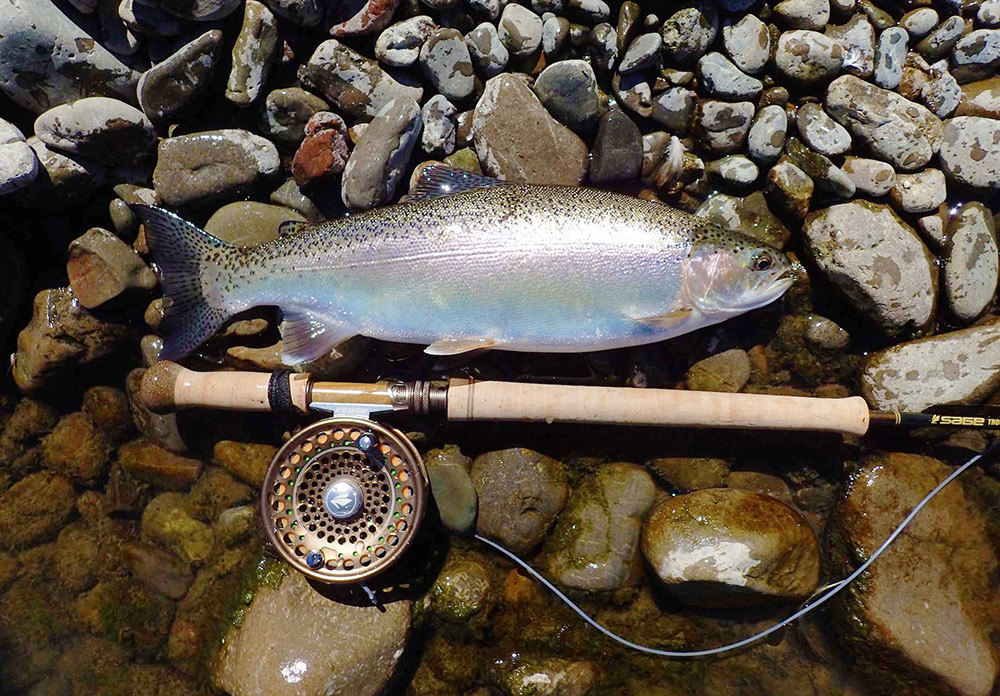
This modest Manawatu River rainbow was one of many that bent the 4wt Trout Spey into the cork, and making runs of at least 20 m
A few months later I had a whale of a time on the Manawatu River near Palmerston North, catching, as well as losing, several well conditioned rainbow and brown trout around 2.5 lb. As small as they were, these fish also managed to bend the 4wt Trout Spey down into the cork, making strong runs of up to 20 meters that belied their size.
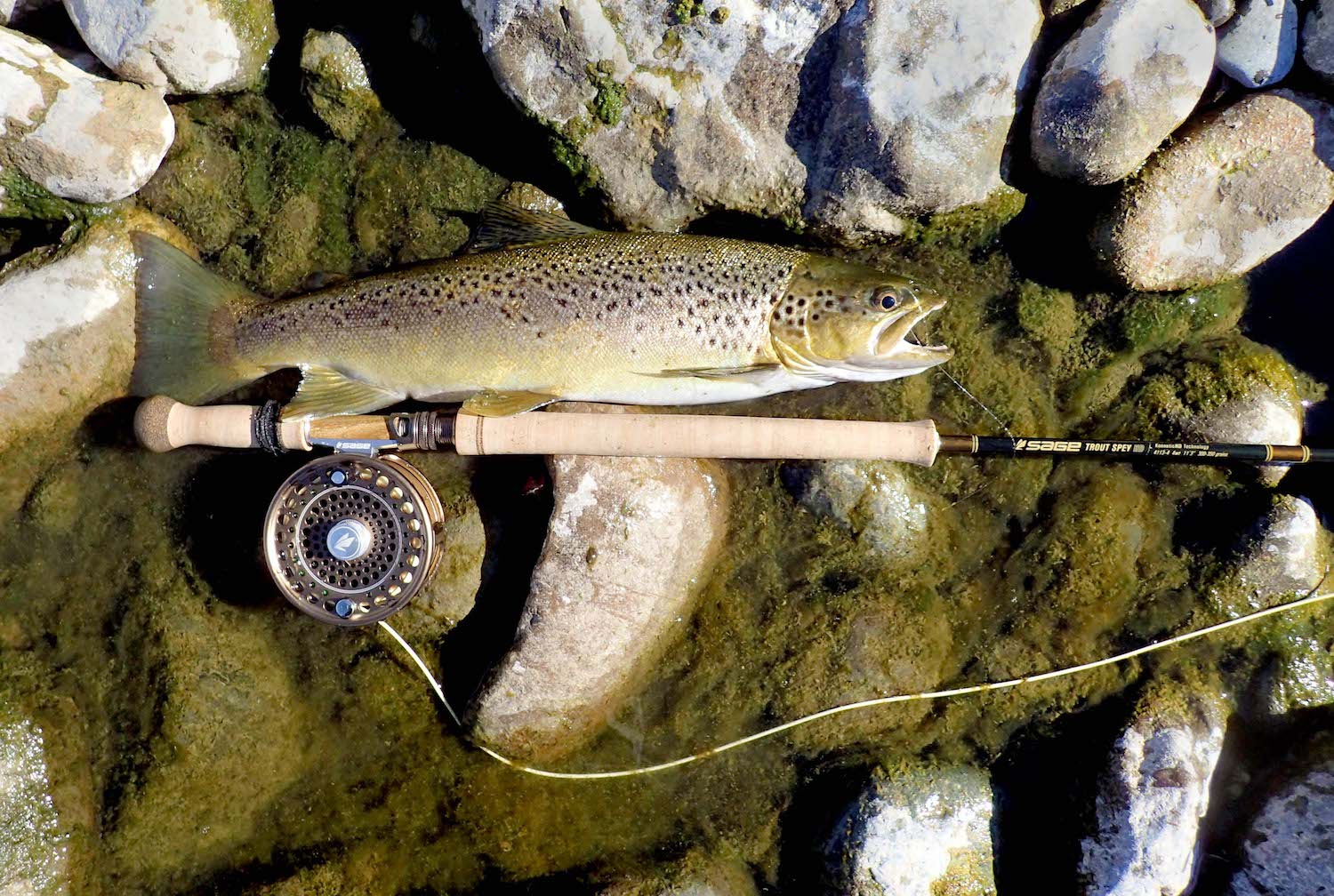
A 2.5 lb brown trout in good condition is no push over on a 4wt Trout Spey
Even though the 4wt Trout Spey effortlessly casts longer sink tips and a heavier Skagit head than I use on my 9.5 foot 7wt single hand rod, it clearly does not have near the pulling power of the 7wt single hander - the consequence of a much softer butt section.
While this translates to a lot of fun with fish of 2-5 pounds in regular flows, it also means the 4wt Trout Spey is likely to struggle with fit 5-10 lb fish in strong water - think trophy sea trout in large South Island salmon rivers and the Tongariro when flowing at >30 cumecs in winter.
While a 5 wt or even a 6wt 12 foot Spey Rod would be ideal for these situations, the heavier outfit would be too long and lacking in finesse on smaller waterways, or during lower summer flow rates.
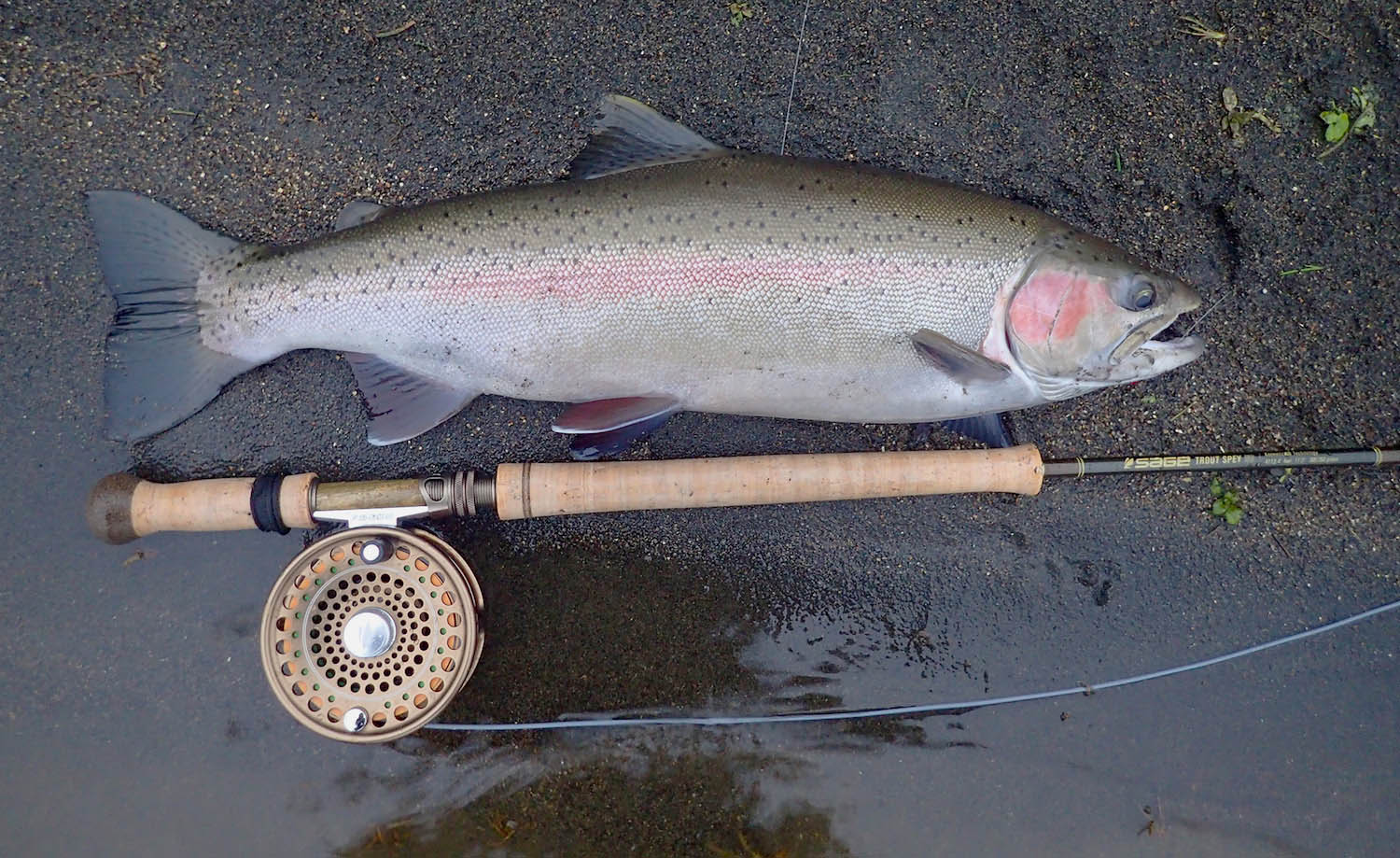
Winter rainbow from the Tongariro taken on the 4wt Trout Spey HD with the 270 grain Scientific Anglers intermediate Skagit head and a 10 ft 110 grain OPST bucket tip
Conclusion
Ideal length and a brilliant blend of power and finesse make the 11.25 foot 4wt Trout Spey HD the perfect tool for fishing streamers on the majority of New Zealand’s medium to large rivers, especially the middle to lowland reaches and estuaries.
This rod together with three heads - Scandi Body and floating and intermediate Skagit heads - and a handful of sink tips allows me to fish anything from small unweighted soft hackles and wet flies to large weighted streamers in a wide range of water depth and flow rate. The 4wt Trout Spey also has the power to deal with serious wind, especially when combined with an appropriate head and tip.
Casting the 4wt Trout Spey is an absolute pleasure, and being feather light it is hard to comprehend how it manages to do all it does with so little effort.
The answer, of course, lies in both the taper and the KonneticHD technology, which allow easy flex and rod load, but with fast recovery to rocket launch heads and tips. Even with my limited two handed experience I could tell the 4wt Trout Spey HD was one special rod.
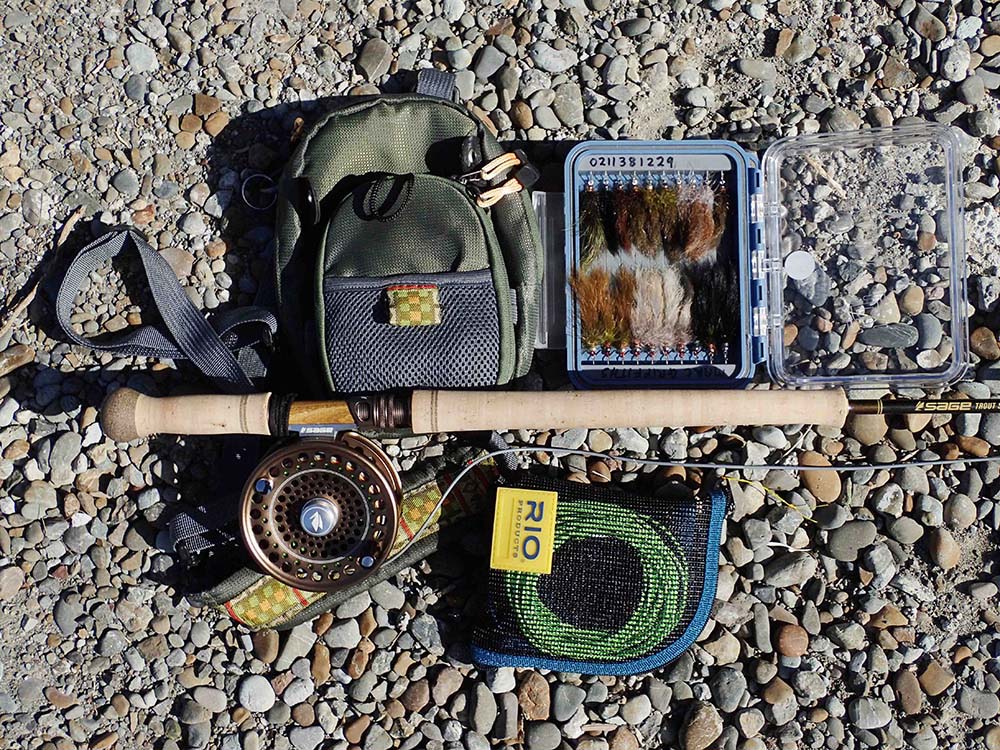
A wallet containing two heads (with a third on the reel) and a handful of sink tips is all I require to fish anything from small unweighted to large weighted streamers in a wide range of water depths and flow rates. Everything I need for a day on the water fits into a tiny chest pack.
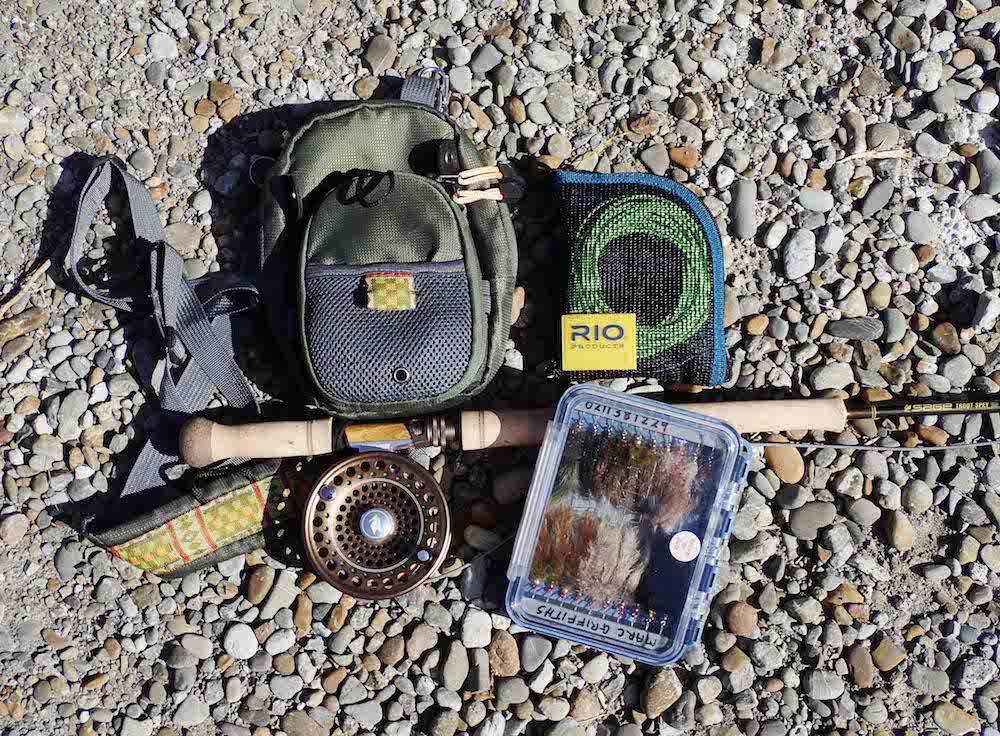
See other reviews :
